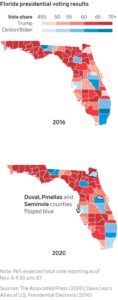
After the results of the 2020 election, it is hard to determine Florida’s standing as a swing state.
President Donald J. Trump gained more support in the 2020 election in Miami-Dade County than in the 2016 election. This gained support was a result of the Cuban American voter turnout. Biden only won Miami-Dade County by 7 margin points, according to the New York Times.
This election saw the worst performance of a Democratic candidate in the county since 2004.
“It’s really hard to argue if Florida is a true swing state,” said Matthew C. Isbell, a Democratic data strategist in South Florida in an interview with the New York Times. “It’s not Missouri. It’s not Ohio, where Trump won by eight points. It’s just more modestly Republican — kind of like North Carolina, but even a little further to the right.”
Donna Shalala and Debbie Mucarsel-Powell, two democratic members of Congress were replaced with Republicans in Miami-Dade County. This congressional election further highlights Florida’s change from Democrat to Republican-leaning, leaving the pressing question of whether or not it’s still considered a swing state.
Five Democratic seats in the house flipped to republican seats in Tallahassee, Fl, further blurring the image of Florida as a swing state and clearing that image into a sea of red. Along with house seats being filled with Republican candidates, so have two open Senate seats.
Although counties such as Duval, Pinellas, and Seminole turned Democrat, there is still a significant amount of state that displays Republican-favoring sentiments in the state.
“I think it’s important to remember that Florida voted Democratic twice in 2008 and 2012, after narrowly being decided Republican in 2000 and voting Republican again in 2004,” said Maurice Gilbert, a third-year political science student at Florida A&M University.
In comparison to the results of the 2016 election, where Clinton won Miami-Dade County by 30 percentage points, there has been a major shift in voting tendencies. A county that should have been a stronghold of Democratic voters has contributed to the overall flip of the state from Democrat to Republican.
This flip has led to overall uncertainty to Florida’s position as a battleground, or swing state in major elections such as the 2020 presidential election.
“It’s difficult and unreasonable to make sweeping assumptions about political realignment within 3 election cycles,” said Gilbert.